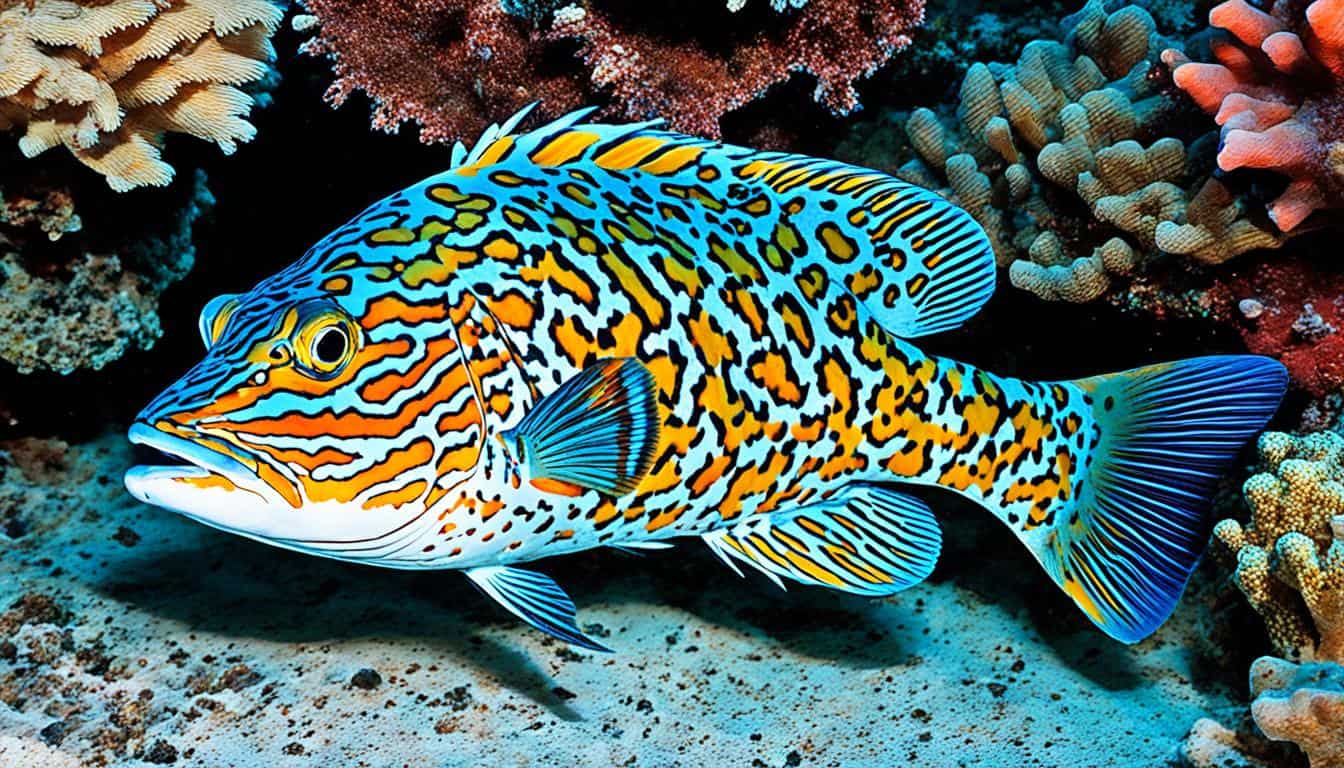Groupers belong to the family Epinephelidae and are fascinating marine fish. They have many adaptations that help them survive. These include special ways of reproducing, choosing where to live, and being resilient to changes in their environment.
These adaptations let groupers live in different marine habitats. They play a key role in their ecosystems.
Learning about grouper adaptations shows their importance as keystone species. It also shows how they interact with their surroundings. Understanding these fish and their habitats is crucial for protecting them for the future.
Understanding Grouper Adaptations
Groupers show amazing ways to adapt to their ocean homes. They use both behavior and body changes to survive and reproduce. Let’s explore how these adaptations help groupers live in tough environments.
Behavioral Adaptations
Groupers have cool ways of reproducing, like gathering in groups to increase their chances of successful fertilization. They can also change sex from female to male based on their surroundings. This helps them find mates and keep their numbers stable.
Physiological Adaptations
Groupers have strong jaws that help them catch food quickly. They can also change color to hide from predators. This camouflage skill is key to their survival and hunting success.
| Adaptation Type | Description | Significance |
|---|---|---|
| Behavioral | Aggregation during spawning | Increases fertilization success |
| Behavioral | One-way sex change | Enhances mating opportunities |
| Physiological | Strong jaws | Effective prey capture |
| Physiological | Camouflage | Predator avoidance mechanism |
Grouper Habitat Preferences
Groupers live in warm-temperate and tropical waters. They like places with lots of resources and safety. This helps them survive and behave in certain ways.
Preferred Environments
Groupers like places that give them shelter and good spots to find food. Their top picks are:
- Coral reefs
- Seagrass beds
- Rocky substrates
- Artificial reefs
These places are key to how groupers adapt to their environment. They help groupers avoid predators and find food easily. Coral reefs and seagrass beds are perfect for young groupers, giving them safe spots to grow.
Juvenile Habitats vs. Adult Habitats
Juvenile and adult groupers live in different places as they grow. Young groupers stay close to the coast, where they hide among plants and reefs. This keeps them safe from big predators. When they get older, they move to deeper waters for spawning.
| Life Stage | Preferred Habitat | Key Characteristics |
|---|---|---|
| Juvenile | Coastal Areas | High cover, shallow waters, abundant food sources |
| Adult | Deeper Reef Areas | Site fidelity for spawning, extensive range, greater shelter |
Knowing where groupers like to live helps us protect their homes. This is good for both young and adult groupers.
Groupers and Their Ecological Niche
Groupers play a big role in the ocean’s balance. They help keep the ecosystem healthy through their actions. Let’s look at how groupers fit into their environment and why they’re important to coral reefs.
Role as Keystone Species
Groupers are key to coral reef health. They eat smaller fish and invertebrates, keeping their numbers in check. This stops some species from taking over and harming the reef.
Without groupers, some species could grow too fast, hurting the reef. So, they’re crucial for a balanced ecosystem.
Interactions with Other Species
Groupers work closely with other sea creatures. They have a special bond with cleaner fish. These fish clean parasites off the groupers, helping them stay healthy.
This helps both the groupers and the reef. It shows how groupers and other sea life depend on each other for survival.

| Species Name | Role in the Ecosystem | Interaction Type |
|---|---|---|
| Groupers | Keystone species aiding in population control | Predation |
| Cleaner Fish | Maintaining grouper health | Mutualism |
| Coral Reefs | Habitat for various marine species | Support system |
Groupers are vital for the ocean’s health and diversity. They show why we need to protect and manage their populations in our changing world.
Grouper Life Cycle and Environmental Challenges
The grouper life cycle is a fascinating journey from pelagic larvae to distinct juvenile and adult stages. Each stage needs specific habitats for survival. Juvenile groupers live in sheltered places like mangroves or seagrass beds for protection and growth. Adults prefer deeper reef habitats for foraging and spawning.
Understanding their habitat needs helps us see the challenges they face. These insights are key to protecting their environments.
Life Stages and Habitat Needs
Groupers move through different life stages, showing how important diverse habitats are. Juveniles stay in safe areas to avoid predators. Adults move to deeper waters for food and to spawn. This life cycle shows how habitat availability affects grouper health.
Protecting these habitats is crucial for grouper populations.
Effects of Climate Change
Climate change poses big challenges for groupers. Rising water temperatures, ocean acidification, and habitat loss harm their populations. These changes disrupt their breeding, affecting their survival and long-term health.
Conservation efforts must tackle these issues to help groupers survive in their habitats.
FAQ
How do groupers adapt to their environment?
Groupers adapt in many ways, like changing their behavior, physiology, and how they reproduce. They gather together to mate and can change sex if needed. This helps them survive in changing populations.
What are some behavioral adaptations of groupers?
Groupers often gather to spawn, which helps them fertilize eggs better. They also hide and use camouflage to avoid predators. This helps them live longer in the ocean.
What physiological adaptations do groupers possess?
Groupers have strong jaws for catching prey. They also have special ways to blend in with their surroundings. This helps them hide from predators and succeed in the ocean.
What are the preferred environments for groupers?
Groupers like warm and tropical waters, especially near coral reefs and seagrass beds. These places give them the cover and food they need to survive.
How do juvenile groupers differ in habitat preferences compared to adults?
Young groupers live in coastal areas for safety. As they grow, they move to deeper reefs for food and to spawn. Adults and juveniles have different places they prefer to live.
How do groupers function as keystone species?
Groupers keep the balance in coral reef ecosystems by controlling smaller species and invertebrates. They help maintain the health of the reefs, making them important for the ocean’s balance.
What types of interactions do groupers have with other species?
Groupers work with cleaner fish and other reef creatures. These partnerships make the reef more complex and support more life. These relationships are key to keeping the reef healthy.
What is the life cycle of groupers like, and what habitat needs do they have?
Groupers go through different stages from larvae to adults. Each stage needs a specific place to live. Young ones need safe spots, while adults prefer deeper reefs for food and breeding. Protecting their habitats is crucial.
What environmental challenges do groupers face?
Climate change is a big threat to groupers, causing warmer waters, ocean acidification, and losing habitats. These changes mess with their breeding and threaten their survival. We need to act fast to save them.
How does climate change affect groupers specifically?
Climate change changes groupers’ homes and messes with their breeding. Warmer waters and ocean acid make it harder for them to find food and stay healthy. This makes them more vulnerable in the ocean.







